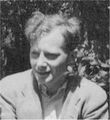Template:Selected anniversaries/November 11: Difference between revisions
Jump to navigation
Jump to search
No edit summary |
No edit summary |
||
| Line 14: | Line 14: | ||
File:Vesto Slipher.gif|link=Vesto Slipher (nonfiction)|1875: Astronomer [[Vesto Slipher (nonfiction)|Vesto Melvin Slipher]] born. He will perform the first measurements of radial velocities for galaxies, providing the empirical basis for the expansion of the universe. | File:Vesto Slipher.gif|link=Vesto Slipher (nonfiction)|1875: Astronomer [[Vesto Slipher (nonfiction)|Vesto Melvin Slipher]] born. He will perform the first measurements of radial velocities for galaxies, providing the empirical basis for the expansion of the universe. | ||
||Wealthy Consuelo Babcock | ||1895: Wealthy Consuelo Babcock born ... mathematician. She was an outstanding teacher at the University of Kansas for thirty years; she was also the mathematics department's librarian. Pic. | ||
||1904 | ||1904: Alger Hiss born ... lawyer and convicted spy. | ||
File:Henry Whitehead.jpg|link=J. H. C. Whitehead (nonfiction)|1904: Mathematician and academic [[J. H. C. Whitehead (nonfiction)|J. H. C. Whitehead]] born. During the Second World War, he will work with the codebreakers at Bletchley Park. | File:Henry Whitehead.jpg|link=J. H. C. Whitehead (nonfiction)|1904: Mathematician and academic [[J. H. C. Whitehead (nonfiction)|J. H. C. Whitehead]] born. During the Second World War, he will work with the codebreakers at Bletchley Park. | ||
||Georg Aumann | ||1906: Georg Aumann born ... mathematician. He was known for his work in general topology and regulated functions. During World War II, he worked as part of a group of five mathematicians, recruited by Wilhelm Fenner, and which included Ernst Witt, Georg Aumann, Alexander Aigner, Oswald Teichmueller and Johann Friedrich Schultze, and lead by Wolfgang Franz, to form the backbone of the new mathematical research department in the late 1930s, which would eventually be called: Section IVc of Cipher Department of the High Command of the Wehrmacht (abbr. OKW/Chi). He also worked as a cryptanalyst, on the initial breaking of the most difficult cyphers. He also researched and developed cryptography theory. Pic. | ||
||Raemer Edgar Schreiber | ||1907: Joseph Gilbert Hamilton born ... professor of Medical Physics, Experimental Medicine, General Medicine, and Experimental Radiology as well as director (1948-1957) of the Crocker Laboratory, part of the Lawrence Berkeley National Laboratory. | ||
||1910: Raemer Edgar Schreiber born ... physicist from McMinnville, Oregon who served Los Alamos National Laboratory during World War II, participating in the development of the atomic bomb. He saw the first one detonated in the Trinity nuclear test in July 1945, and prepared the Fat Man bomb that was used in the bombing of Nagasaki. After the war, he served at Los Alamos as a group leader, and was involved in the design of the hydrogen bomb. In 1955, he became the head of its Nuclear Rocket Propulsion (N) Division, which developed the first nuclear-powered rockets. Pic. | |||
||1911: Enzo Martinelli born ... mathematician, working in the theory of functions of several complex variables: he is best known for his work on the theory of integral representations for holomorphic functions of several variables, notably for discovering the Bochner–Martinelli formula in 1938, and for his work in the theory of multi-dimensional residues. | ||1911: Enzo Martinelli born ... mathematician, working in the theory of functions of several complex variables: he is best known for his work on the theory of integral representations for holomorphic functions of several variables, notably for discovering the Bochner–Martinelli formula in 1938, and for his work in the theory of multi-dimensional residues. | ||
| Line 40: | Line 42: | ||
||1930: Mildred Dresselhaus born ... known as the "queen of carbon science" | ||1930: Mildred Dresselhaus born ... known as the "queen of carbon science" | ||
||1940 | ||1940: World War II: The German auxiliary cruiser Atlantis captures top secret British mail from the Automedon, and sends it to Japan. | ||
|| | ||1951: Kim Peek born ... megasavant. | ||
File:Hugh Everett III.jpg|link=Hugh Everett III (nonfiction)|1930: Physicist [[Hugh Everett III (nonfiction)|Hugh Everett III]] born. He will propose the many-worlds interpretation (MWI) of quantum physics. | File:Hugh Everett III.jpg|link=Hugh Everett III (nonfiction)|1930: Physicist [[Hugh Everett III (nonfiction)|Hugh Everett III]] born. He will propose the many-worlds interpretation (MWI) of quantum physics. | ||
| Line 50: | Line 50: | ||
File:Cantor Parabola defies the National Security Agency.jpg|link=Cantor Parabola|1933: [[Cantor Parabola]] warns that [[crimes against mathematical constants]] are on the rise. | File:Cantor Parabola defies the National Security Agency.jpg|link=Cantor Parabola|1933: [[Cantor Parabola]] warns that [[crimes against mathematical constants]] are on the rise. | ||
||1966 | ||1966: NASA launches Gemini 12. | ||
||1967: Lester Randolph Ford Sr. dies ... mathematician. | |||
|| | ||1973: Artturi Ilmari Virtanen dies ... chemist and academic, Nobel Prize laureate. | ||
|| | ||2003: Andrei Bolibrukh dies ... mathematician. He was known for his work on ordinary differential equations especially Hilbert's twenty-first problem (Riemann–Hilbert problem). Pic: http://www.mi-ras.ru/index.php?c=inmemoria&l=1 | ||
File:Venus Express in orbit.jpg|link=Venus Express (nonfiction)|2005: The [[Venus Express (nonfiction)|Venus Express]] successfully performs its first trajectory correction maneuver. | File:Venus Express in orbit.jpg|link=Venus Express (nonfiction)|2005: The [[Venus Express (nonfiction)|Venus Express]] successfully performs its first trajectory correction maneuver. | ||
||2014 | ||2014: Philip G. Hodge dies ... engineer and academic. | ||
</gallery> | </gallery> | ||
Revision as of 08:04, 14 September 2018
1675: Mathematician Gottfried Leibniz demonstrates integral calculus for the first time to find the area under the graph of y = ƒ(x).
1875: Astronomer Vesto Melvin Slipher born. He will perform the first measurements of radial velocities for galaxies, providing the empirical basis for the expansion of the universe.
1904: Mathematician and academic J. H. C. Whitehead born. During the Second World War, he will work with the codebreakers at Bletchley Park.
1930: Physicist Hugh Everett III born. He will propose the many-worlds interpretation (MWI) of quantum physics.
1933: Cantor Parabola warns that crimes against mathematical constants are on the rise.
2005: The Venus Express successfully performs its first trajectory correction maneuver.





